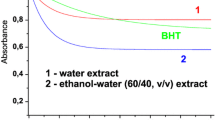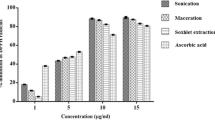Abstract
Hot water extract (HWE) from Pinus radiata bark was fractionated into monomeric polyphenol (MPP), oligomeric proanthocyanidin (OPA), and polymeric proanthocyanidin (PPA) fractions by monitoring the UV-visible spectrum of the eluted fractions. Nine polyphenols were identified in MPP: three phenolic acids and six flavonoids. The major compounds of MPP were taxifolin (456 μg/mg), catechins (240 μg/mg), and protocatechuic acid (46.2 μg/mg). The OPA components ranged from dimers to hexamers. PPA comprised procyanidin (PC, 94%), a small amount of prodelphinidin (PD, 6%), and also the higher trans configuration, rather than the cis configuration, of C2-C3. The average molecular weight (Mw, Mn), polydispersity (Mw/Mn), and DP of PPA were 3,800 (Mw), 1,200 (Mn), 3.2 and 13, respectively. The potential antioxidant activities of HWE and the three fractions were estimated using proton- or electron-donating assays containing 1,1-diphenyl-2-picrylhydrazyl (DPPH) free radical, 2,2′-azinobis(3-ethylbenzothiazoline-6-sulfonate) (ABTS) radical cation, superoxide anion (O •−2 ), hydrogen peroxide (H2O2), reducing power and lipid peroxidation. All the bark fractions exhibited potent quenching abilities against both commercially available radicals (DPPH•, ABTS•+) and chemically induced radicals (H2O2, O •−2 ), as well as strong reducing power and inhibitory activity of lipid peroxidation. Particularly, OPA showed a hydrogen peroxide scavenging activity significantly higher (p < 0.05) than that of the other fractions. From 2-thiobarbituric acid reactive substances and ferric thiocyanate assays, PPA was suspected to act by essentially delaying the formation of hydroperoxide by quenching free oxygen radicals that operates in oil-in-water emulsion.




Similar content being viewed by others
References
Amarowicz R, Pegg RB, Rahimi-Moghaddam P, Barl B, Weil JA (2004) Free-radical scavenging capacity and antioxidant activity of selected plant species from the Canadian prairies. Food Chem 84:551–562
Bagchi D, Bagchi M, Stohs SJ, Das DK, Ray SD, Kuszynski CA, Joshi SS, Pruess HG (2000) Free radicals and grape seed proanthocyanidin extract: importance in human health and disease prevention. Toxicology 148:187–197
Banerjee A, Dasgupta N, De B (2005) In vitro study of antioxidant activity of Syzygium cumini fruit. Food Chem 90:727–733
Bienert GP, Schjoerring JK, Jahn TP (2006) Membrane transport of hydrogen peroxide. Biochim Biophys Acta 1758:994–1003
Costa D, Gomes A, Reis S, Lima JLFC, Fernandes E (2005) Hydrogen peroxide scavenging activity by non-steroidal anti-inflammatory drugs. Life Sci 76:2841–2848
De Bruyne T, Pieters L, Deelstra H, Vlietinck A (1999) Condensed vegetable tannins: biodiversity in structure and biological activities. Biochem Syst Ecol 27:445–459
Gonçalves C, Dinis T, Batista MT (2005) Antioxidant properties of proanthocyanidins of Uncaria tomentosa bark decoction: a mechanism for anti-inflammatory activity. Phytochemistry 66:89–98
Gülçin İ, Büyükokuroğlu ME, Küfrevioğlu Öİ (2003a) Metal chelating and hydrogen peroxide scavenging effects of metatonin. J Pineal Res 34:278–281
Gülçin İ, Büyükokuroğlu ME, Oktay M, Küfrevioğu Öİ (2003b) Antioxidant and analgesic activities of turpentine of Pinus nigra Arn. subsp. Pallasiana (Lamb.) Holmboe J Ethnopharm 86:51–58
Gülçin İ (2006) Antioxidant and antiradical activities of l-carnitine. Life Sci 78:803–811
Heim KE, Tagliaferro AR, Bobilya DJ (2002) Flavonoid antioxidants: chemistry, metabolism and structure-activity relationships. J Nutr Biochem 13:572–584
Jiao Z, Liu J, Wang S (2005) Antioxidant activities of total pigment extract from blackberries. Food Technol Biotechnol 43:97–102
Jung CH, Seog HM, Choi IW, Cho HY (2005) Antioxidant activities of cultivated and wild Korean ginseng leaves. Food Chem 92:535–540
Kim YM, Wang MH, Rhee HI (2004) A novel α-glucosidase inhibitor from pine bark. Carbohydrate Res 339:715–717
Kondo K, Kurihara M, Fukuhara K, Tanaka T, Suzuki T, Miyata N, Toyoda M (2000) Conversion of procyanidin B-type (catechin dimer) to A-type: evidence for abstraction of C-2 hydrogen in catechin during radical oxidation. Tetrahedron Lett 41:485–488
Ku CS, Mun SP (2007) Characterization of proanthocyanidin in hot water extract isolated from Pinus radiata bark. Wood Sci Technol 41:235–247
Lotito SB, Actis-Goretta L, Renart ML, Caligiuri M, Rein D, Schmitz HH, Steinberg FM, Keen CL, Fraga CG (2000) Influence of oligomer chain length on the antioxidant activity of procyanidins. Biochem Biophys Res Commun 276:945–951
Lu Y, Foo LY (2000) Antioxidant and radical scavenging activities of polyphenols from apple pomace. Food Chem 68:81–85
Mansouri A, Makris DP, Kefalas P (2005) Determination of hydrogen peroxide scavenging activity of cinnamic and benzoic acids employing a highly sensitive peroxyoxalate chemiluminescence-based assay: structure-activity relationships. J Pharm Biomed Anal 39:22–26
Mun SP, Ku CS (2006) Characterization of low molecular weight polyphenols from pine (Pinus radiata) bark. Food Sci Biotechnol 15:424–430
Nanjo F, Goto K, Seto R, Suzuki M, Sakai M, Hara Y (1996) Scavenging effects of tea catechins and their derivatives on 1,1-diphenyl-2-picrylhydrazyl radical. Free Radic Biol Med 21:895–902
Packer L, Rimbach G, Virgili F (1999) Antioxidant activity and biologic properties of a proanthocyanidin-rich extract from Pine (Pinus maritima) bark, Pycnogenol. Free Radic Biol Med 27:704–724
Rahmat A, Kumar V, Fong LM, Endrini S (2003) Determination of total antioxidant activity in three types of local vegetables shoots and the cytotoxic effect of their ethanolic extracts against different cancer cell lines. Asia Pacific J Clin Nutr 12:292–295
Rice-Evans CA, Miller NJ, Paganga G (1996) Structure-antioxidant activity relationships of flavonoids and phenolic acids. Free Radic Biol Med 20:933–956
Shimada K, Fujikawa K, Yahara K, Nakamura T (1992) Antioxidative properties of xanthum on the autoxidation of soybean oil in cyclodextrin emulsion. J Agric Food Chem 40:945–948
Sokmen M, Angelova M, Krumova E, Pashova S, Ivancheva S, Sokmen A, Serkedjieva J (2005) In vitro antioxidant activity of polyphenol extracts with antiviral properties from Geranium sanguineum L. Life Sci 76:2981–2993
Svedström U, Vuorela H, Kostiainen R, Huovinen K, Laakso I, Hiltunen R (2002) High-performance liquid chromatographic determination of oligomeric procyanidins from dimers up to the hexamer in hawthorn. J Chrom A 968:53–60
Tanner GJ, Francki KT, Abrahams S, Watson JM, Larkin PJ, Ashton AR (2003) Proanthocyanidin biosynthesis in plants: purification of legume leucoanthocyanidin reductase and molecular cloning of its cDNA. J Biol Chem 278:31647–31656
Wood JE, Senthilmohan ST, Peskin AV (2002) Antioxidant activity of procyanidin-containing plant extracts at different pHs. Food Chem 77:155–161
Yuan YV, Bone DE, Carrington MF (2005) Antioxidant activity of dulse (Palmaria palmata) extract evaluated in vitro. Food Chem 91:485–494
Acknowledgements
This study was supported by the Technology Development Program for Agricultural and Forestry, Ministry of Agriculture and Forestry, Republic of Korea.
Author information
Authors and Affiliations
Corresponding author
Rights and permissions
About this article
Cite this article
Ku, C.S., Mun, S.P. Antioxidant properties of monomeric, oligomeric, and polymeric fractions in hot water extract from Pinus radiata bark. Wood Sci Technol 42, 47–60 (2008). https://doi.org/10.1007/s00226-007-0150-9
Received:
Published:
Issue Date:
DOI: https://doi.org/10.1007/s00226-007-0150-9




